Recent Articles
Popular Makes
Body Types
2020 Lexus GS Road Test and Review

20lexusgsffrontbeauty3sessions ・ Photo by Ron Sessions
Model year 2020 marks a bittersweet farewell for the Lexus brand’s premium mid-size sedan after a 27-year run. Seems most of the buyers have run off to SUV-ville.
A bit of an oddity in the current Lexus realm, the GS sedan is an understated gem, spindle-shaped grille and all. The four-door’s flanks are clean of any surface excitement or filigree. Except for the novel shark gill vertical fender slits and diagonally canted quad exhausts of the GS F performance variant, the GS looks muted and subdued and not likely to raise any eyebrows prior to its retirement. Top sellers in the segment include the well-established Mercedes-Benz E-Class, BMW 5 Series, and Audi A6. The 2020 Lexus GS lineup includes the base GS 350, GS 350 F Sport, GS 350 F Sport Black Line, and the GS F. Including the mandatory $1,025 destination charge, prices run from $52,090 to $86,035. The GS 350 is available with a choice of rear- or all-wheel drive, but the GS F is rear-drive only.
Go Power
Although previous powertrain choices included a four-cylinder turbo and a gas-electric hybrid, the 2020 engine selection has distilled down to the workhorse 3.5-liter V6 and special-issue GS F 5.0-liter V8. The V6 makes a healthy 311 horsepower and 280 lb-ft of torque, powering rear-drive versions of the mid-size sedan from rest to 60 mph in 5.7 seconds. All-wheel-drive applications take another tenth of a second to accomplish the feat. EPA estimates are 19 to 20 mpg city, 28 to 29 mpg highway, and 22-23 mpg combined for RWD GS 350 models and 19 mpg city/26 mpg highway/22 mpg combined for AWD versions.
Our GS F test vehicle shares its V8 engine with the Lexus RC F and LC 500 coupes. It has melodic induction and exhaust sounds (slightly enhanced by the audio speakers). And the heady 7300-rpm rev limit is unexpected in this class. The V8 storms to 60 mph in 4.5 seconds while netting a 16 mpg city/24 mpg highway/19 mpg combined EPA rating. I saw an indicated 21 mpg over a week that included residential quick hops and a 250-mile backroad highway tour. Rear-drive powertrains are teamed with a silky eight-speed automatic transmission while AWD versions use an older-design six-speed automatic.
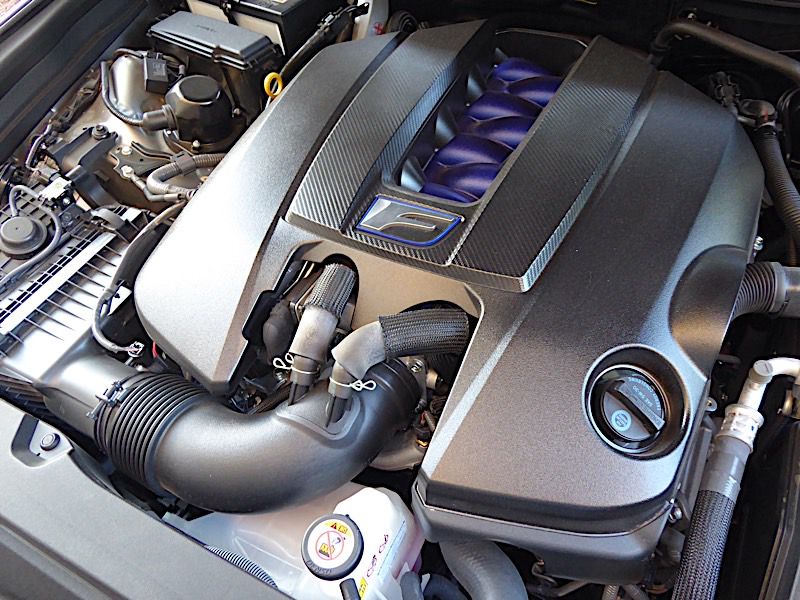
Photo by Ron Sessions
Luxury to Go
The Lexus GS is roomy enough to carry four adults in luxury-steeped comfort. The current (fourth-generation) Lexus GS has been in-market for going on seven years now, an eternity in the fashion-conscious mid-size premium segment, but it’s wearing well. Outward visibility is good, thanks to trim windshield pillars, free-standing side mirrors, and a tidy dash top. Although it’s showing its age, the cabin of the GS manages to look contemporary while offering time-honored favorites such as a dash-mounted analog clock (enhanced with GPS time-zone functionality).
The supportive and comfortable power-operated front seats are leather-covered in all but the GS 350 AWD model (which gets standard faux leather). Power lumbar adjustment and driver memory are standard as well, along with soft-touch material wrapping the upper dash, console sides, and door trim panels. The standard power tilting and telescoping steering wheel is leather-wrapped and tilts away for easy ingress and egress. The GS 350 F Sport and GS F upgrade to more aggressively bolstered form-hugging front buckets with power side bolsters and thigh support. You may want to take your wallet out of your back pants pocket for comfort on longer trips, however.
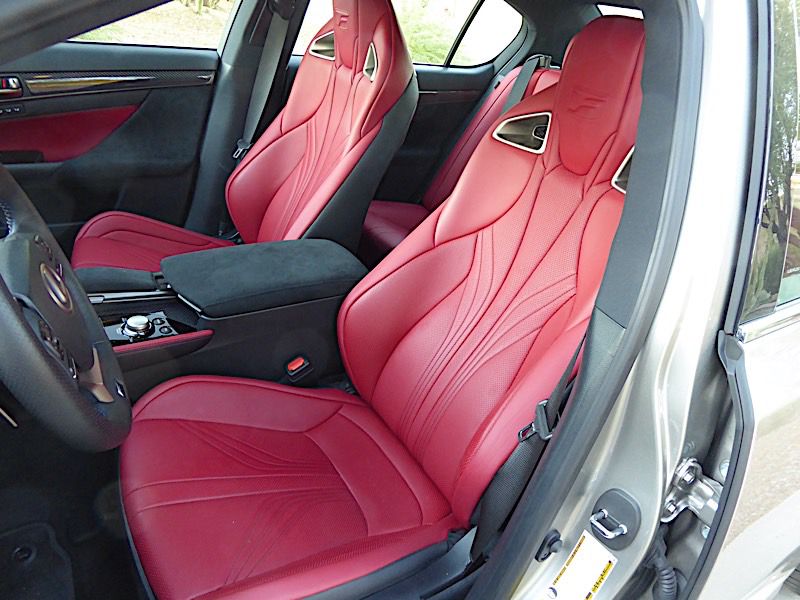
Photo by Ron Sessions
Gauging Performance
In the GS 350 F Sport and GS F is an LFA supercar-inspired instrument binnacle. It features a large analog tachometer surrounding a digital speed readout, a smaller analog speedometer, and a configurable section with three tiny bar graph gauges for fuel level, coolant and engine oil temperature that could be the smallest anyone’s seen.
In the GS F, drivers can summon performance data in the display such as G-force, torque distribution, or a lap timer in addition to fuel economy, navigation information, and other more sanguine bits of vehicle data.
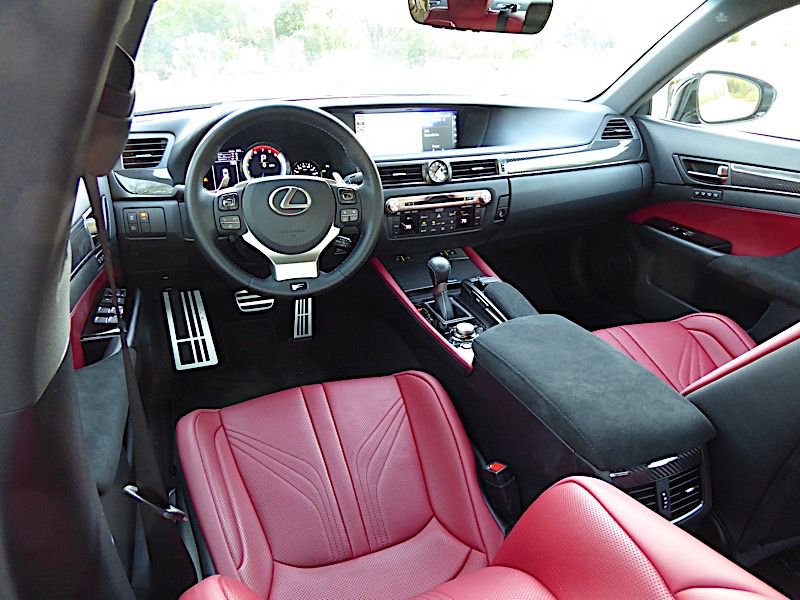
Photo by Ron Sessions
Staying Infotained
In 2013, the Lexus GS was one of the first cars with a large infotainment screen — and at 12.3 inches, it’s still one of the biggest horizontal-format displays around. Full-screen navigation is standard issue. Content is accessed via a slightly fussy mouse-like console-mounted controller, or by voice or steering wheel controls. The Lexus Enform App Suite enables access to applications such as Yelp, iHeartRadio, Slacker, and others.
For tunes, the GS comes standard with a 12-speaker AM/FM/DVD 5.1 surround sound stereo with SiriusXM satellite radio and HD radio that includes complimentary traffic and weather updates. There is a Cache Radio feature that gives the ability to pause live AM/FM or HD radio broadcasts for later listening. An optional 835-watt, 17-speaker Mark Levinson system with a six-disc in-dash CD/DVD changer is also available and delivers big sound. However, as Lexus is planning to discontinue the GS after the 2020 model year, the automaker has not updated the car’s infotainment system with tech such as Apple CarPlay and Android Auto cellphone mirroring or in-car Wi-Fi.
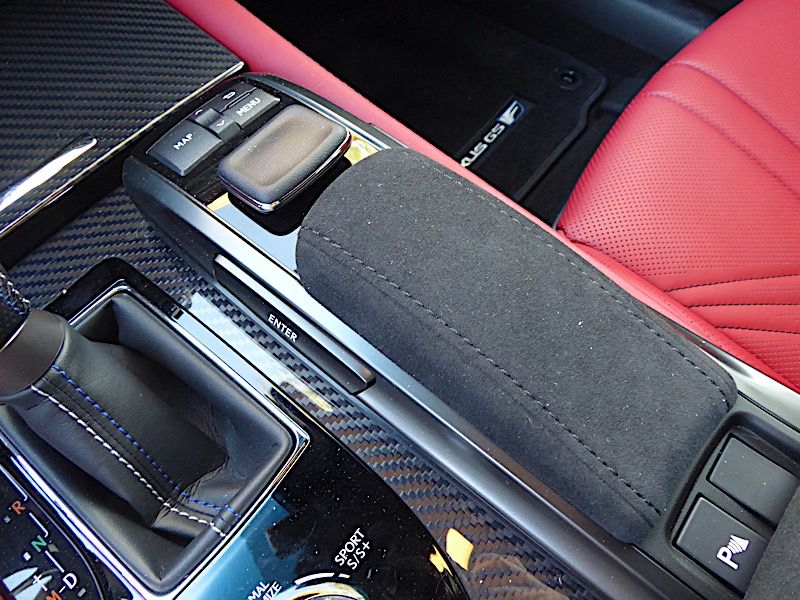
Photo by Ron Sessions
Along for the Ride
Offering nearly the same degree of support and comfort as the front seats, the GS’s outboard rear perches are as accommodating as they are stylish.
There’s enough head, leg, and shoulder space back there for two adults to travel with dignity. Fold up the rear center armrest and a child or pet can ride along as well. Rear seat accouterments include second-row temperature controls and ventilation outlets as well as a power rear sunshade. By mid-size sedan standards, the GS 350’s trunk is huge, offering a full-size-like 18.4 cubic feet of luggage space. The GS F has a more modest 14 cubic feet.
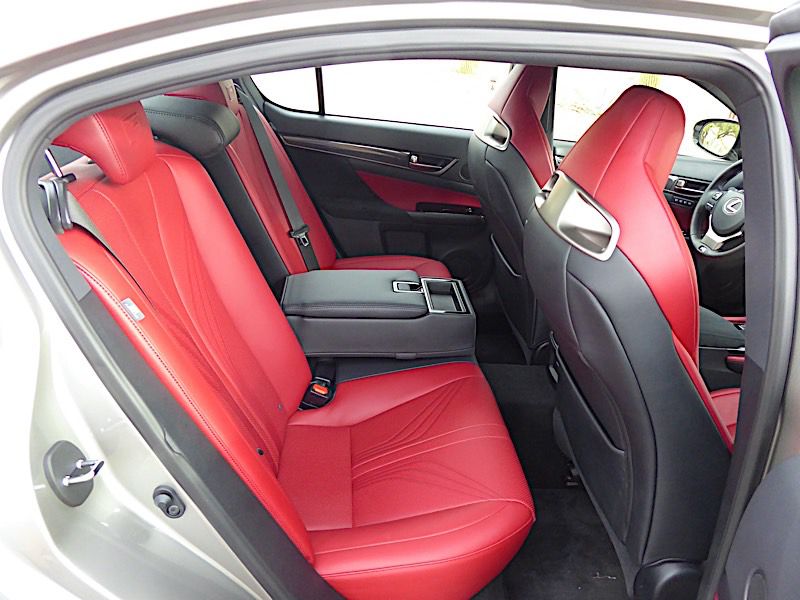
Photo by Ron Sessions
Safety and Driver-Assistive Features
With Lexus about to cease production of the GS after the 2020 model year, the current car doesn’t get all of the latest safety and driver-assistive systems the brand has been introducing on its other models. Still, it’s no lightweight among sedans, with 10 airbags protecting occupants.
In addition to a backup camera, standard safety tech in the 2020 Lexus GS includes a pre-collision system with pedestrian detection, blind-spot and rear cross-traffic monitoring, all-speed dynamic radar cruise control, and a lane-departure alert with lane keep assist. A head-up display is also available. The GS is also equipped with Safety Connect that includes a stolen vehicle locator, enhanced roadside assistance, automatic crash notification, and an emergency assist button. The Insurance Institute for Highway Safety gave the 2020 Lexus GS top scores of Good for moderate-offset front impacts, side impacts, and roof strength.
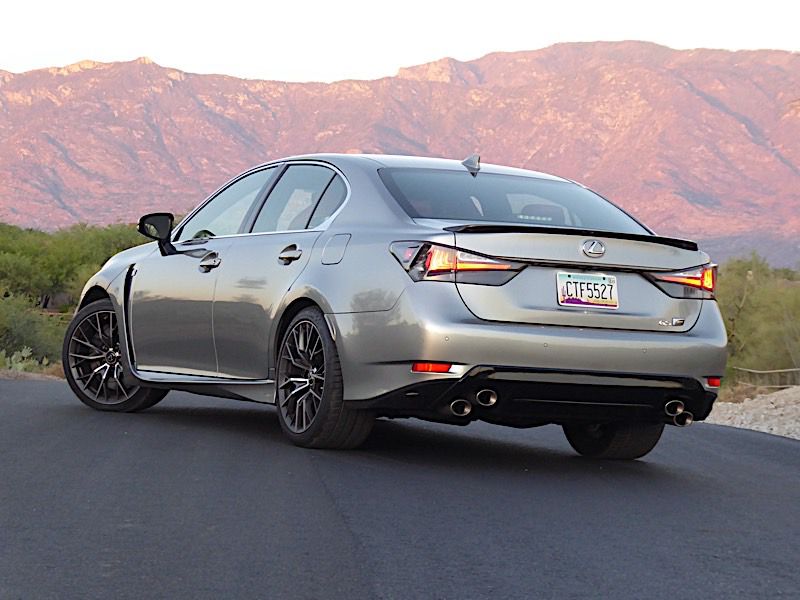
Photo by Ron Sessions
Rolling Stock
The Lexus GS benefits from a rigid body that provides a firm foundation for the aluminum-intensive, weight-reducing, double-wishbone front and multi-link rear suspension. Weight distribution for most versions is a desirable 53% front/47% rear. GS 350 F Sport and GS F models are equipped with adaptive shocks. These replace the passive, gas-charged dampers used on base trims and can deliver a better mix of vertical suspension control and ride comfort by adjusting damping individually at each wheel — say, to take the edge off a sharp bump or pothole or firm up the suspension for hard cornering — in real-time.
Rear-drive GS 350 F Sport models are available with a limited-slip rear differential for improved traction, and dynamic rear-wheel steering that tightens steering response. It gets even better with the GS F, which really shines with sharp, quick, well-weighted steering. With the GS F’s standard torque-vectoring differential, turn-in is sharpened. The driver points and the car obeys. Large-diameter, ventilated Brembo brakes deliver synaptic response. Riding on forged-aluminum 19-inch BBS wheels wrapped with Michelin Pilot Super Sport performance tires, the GS F exhibits exceptional stick. The GS F’s ride is brilliantly damped: firm but never harsh.
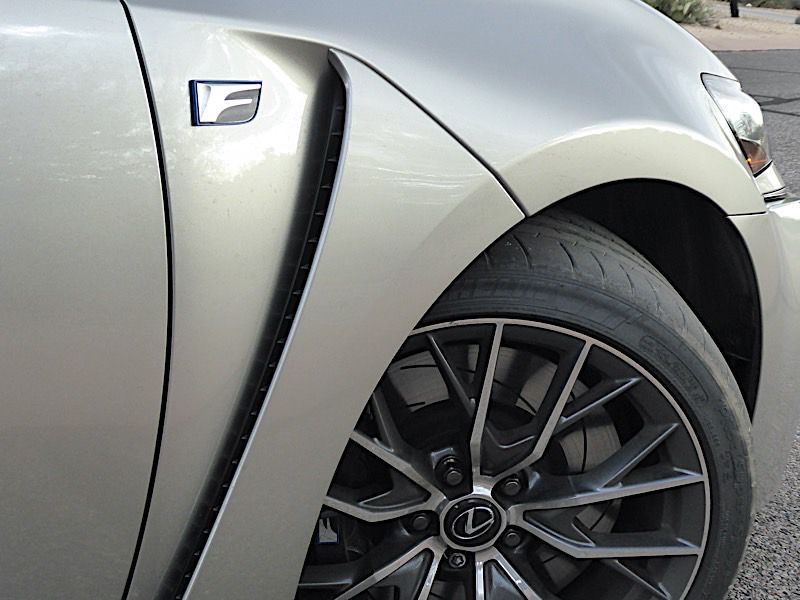
Photo by Ron Sessions
Drive Mode Select
A console-mounted drive mode select knob gives the driver the ability to custom tailor dynamic performance. Eco damps throttle response and hastens upshifts for enhanced fuel economy. Sport S keeps the engine in the fatter part of its powerband. Sport S+ mode on GS 350 F Sport and GS F models raises revs too but also tightens damping rates, firms up the steering, and, in the GS F, adjusts traction control and its torque-vectoring differential for maximum performance.
Available all-wheel drive gives GS 350 buyers in Northern climes the convenience of year-round driving opportunities. The AWD has an electronically controlled center differential that apportions drive torque to the wheels, with a baseline split of 30% front and 70% rear under dry, good-traction conditions. This gives AWD-equipped GS models the expected rear-wheel bias expected in the performance mid-size sedan class. The system can increase the split to an even 50% front/50% rear when road surfaces get slippery.
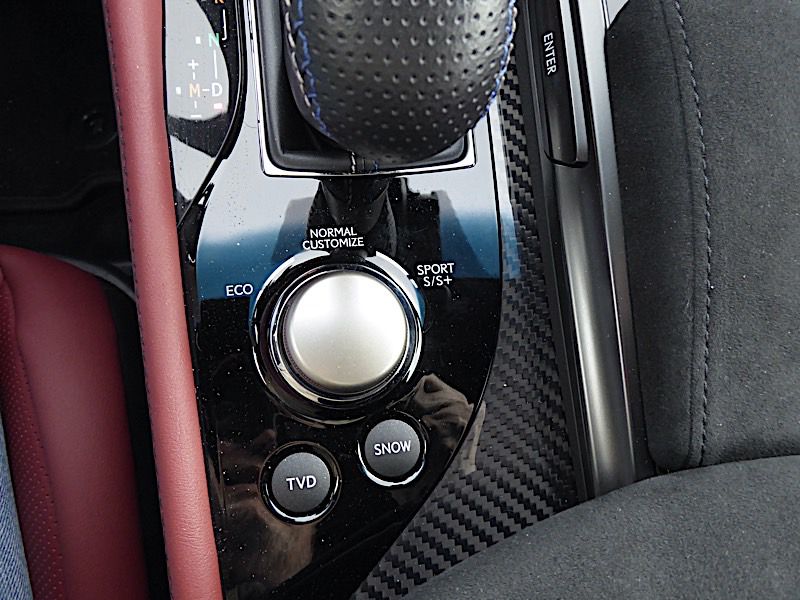
Photo by Ron Sessions
Last Chance
Now in its final model year, the Lexus GS family of mid-size luxury performance sedans combines driving dynamics and luxury fitments comparable to established European entries such as the BMW 5 Series, Mercedes-Benz E-Class, and Audi A6 with the Japanese brand’s longstanding reputation for reliability and lower cost of ownership.
As with many other luxury brands, Lexus will now concentrate on updating its crossover and SUV lineup and introducing new, more advanced hybrids and electric vehicles. In the meantime, the 2020 Lexus GS 350 and GS F will remain enticing performance luxury sedan alternatives in an SUV-crazed marketplace — until they are gone.

Photo by Ron Sessions